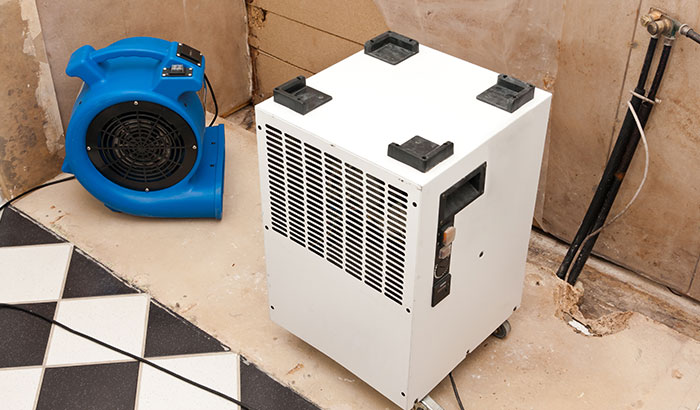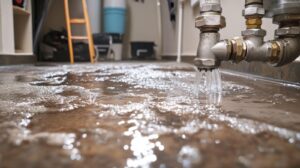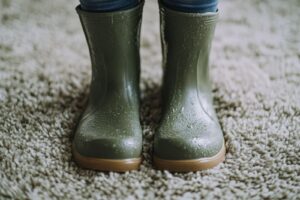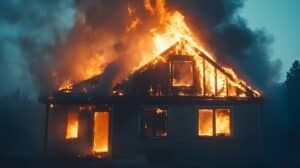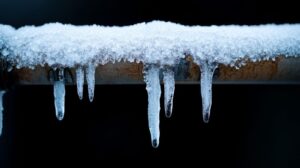Smoke damage refers to the harmful effects caused by exposure to smoke and the substances it carries during various combustion processes. It’s essential to recognize smoke damage as it can seriously affect your property and health.
Smoke damage occurs when the byproducts of incomplete combustion, such as soot, ash, and volatile organic compounds (VOCs), interact with surfaces and air in your home or property. When materials burn incompletely, they release these particles into the air, which can settle on various surfaces and cause visible and invisible damage.
Smoke damage can result from various sources, with fires being the most obvious and severe. However, other everyday activities like cooking can also contribute to smoke damage, especially when food is burnt or oil is overheated. Smoking tobacco products indoors and using candles or incense can also introduce smoke particles into the environment.
Different Types of Smoke and Their Effects on Materials
Wet smoke is the result of slow-burning, smoldering fires that produce a sticky, pungent residue. This type of smoke damage is challenging to clean because strong odors often accompany the soot particles. The sticky nature of wet smoke can cause it to adhere tenaciously to surfaces, making thorough cleaning more difficult.
Dry smoke results from high-temperature, fast-burning fires. It produces a fine, powdery residue that spreads further and adheres lightly to surfaces. While dry smoke damage may seem less severe, it can cause discoloration and leave an unpleasant odor behind.
Protein smoke damage commonly occurs in kitchen settings when meat, poultry, or fish are cooked at high temperatures. This type of smoke is nearly invisible, leaving a thin, greasy film on surfaces. Over time, this film can discolor and corrode metal objects and surfaces.
Fuel oil soot results from furnace puff-backs or other incidents involving heating systems that utilize fuel oil. The soot produced is a black, sticky substance that can quickly spread throughout the property, affecting walls, furniture, and personal belongings.
Depending on the source and type of smoke, the restoration process may vary, making it essential to identify the specific type of smoke damage to implement the most effective cleaning and restoration methods. Knowing the signs of smoke damage and its potential sources, you can take appropriate actions to prevent further harm and ensure a safe and healthy living environment.
7 Signs of Smoke Damage
Smoke damage can leave behind a trail of evidence, and recognizing these signs is crucial for addressing the issue promptly and effectively. Here are seven key signs of smoke damage to watch out for.
- Discoloration and Stains
Yellowing or Browning on Walls, Ceilings, and Surfaces
Smoke contains various particles and chemicals that can discolor surfaces over time. If you notice yellow or brown stains on walls, ceilings, or other surfaces, it is likely a result of smoke damage. These stains can be particularly evident in areas near the source of the smoke, such as around light fixtures and vents.
Dark Stains on Fabrics and Upholstery
Smoke particles can penetrate fabrics and upholstery, leaving dark, persistent stains. These stains can be difficult to remove using conventional cleaning methods and may require professional attention to restore the affected items.
Residue Buildup on Glass and Other Smooth Surfaces
Smoke often leaves behind a sticky, greasy residue on glass, mirrors, and other smooth surfaces. This residue can obscure visibility and make cleaning more challenging, but with proper cleaning techniques, it can be removed.
- Lingering Smoky Odor
The lingering smoky odor is one of the most apparent signs of smoke damage. Even after visible signs of damage are addressed, the distinct smell of smoke may persist. This odor can permeate walls, furniture, and carpets, making it essential to take proactive steps to eliminate it.
Experienced professionals can often discern between fresh and old smoke smells. The age of the smoke odor can indicate the extent and duration of the damage, which can be crucial for determining the best restoration approach.
- Soot Deposits
Soot is a black, powdery substance that results from incomplete combustion. It can accumulate on walls, ceilings, and objects near the source of the smoke. Soot is unsightly and can be hazardous when inhaled, especially for individuals with respiratory conditions.
Soot Accumulation in HVAC Systems and Vents
Smoke particles can also find their way into your HVAC system and vents. Over time, soot can build up in these systems, affecting their efficiency and potentially spreading smoke odors throughout your home. Regular maintenance and cleaning of HVAC systems are essential to prevent further smoke damage.
- Damaged Electronics and Appliances
Smoke particles can infiltrate electronic devices, causing them to malfunction or even fail. Signs of smoke damage in electronics include unusual noises, glitches, and overheating. Avoid using smoke-damaged electronics and seek professional evaluation or repair if needed.
Smoke damage can compromise the safety and functionality of household appliances. Smoke residues can interact with electrical components, leading to potential fire hazards. It is essential to have appliances inspected and repaired by professionals before use.
- Changes in Indoor Air Quality
Smoke damage can degrade indoor air quality by introducing airborne particles, including soot and VOCs, which can trigger respiratory issues and allergies.
Prolonged exposure to poor indoor air quality can lead to various health problems, especially for vulnerable individuals such as children, the elderly, and those with pre-existing respiratory conditions. Improving indoor air quality through proper smoke damage restoration is crucial for safeguarding occupants’ health.
- Warping and Corrosion
Smoke damage can cause wood, plastic, and metal to warp or deform due to the heat and corrosive nature of smoke residues. This can affect the structural integrity and aesthetics of the affected items.
Smoke residues can contain acidic components that corrode metal surfaces over time. This corrosion can weaken metal structures and require specialized cleaning and restoration techniques.
- Health Symptoms in Occupants
Respiratory Problems like Coughing, Wheezing, and Shortness of Breath
Smoke particles and pollutants released during combustion can irritate the respiratory system, leading to coughing, wheezing, shortness of breath, and exacerbation of existing respiratory conditions.
Allergic Reactions and Irritations Caused by Smoke-Damaged Materials
Smoke damage can trigger allergic reactions and irritations, such as skin rashes and eye irritations, in sensitive individuals. Identifying and addressing the source of smoke damage can help alleviate these health concerns.
By being vigilant for these seven signs of smoke damage, you can take the necessary steps to mitigate the effects and safeguard your property and well-being.
Whether the damage is visible or hidden, seeking professional smoke damage restoration services can help restore your home to a safe and habitable condition. Remember, addressing smoke damage promptly is crucial for preventing further deterioration and ensuring a healthier living environment for you and your loved ones.
Dealing Smoke Damage
Dealing with smoke damage can be daunting, but taking immediate action and following best practices can significantly prevent further harm and restore your property. Here’s a comprehensive guide on how to prevent and mitigate smoke damage effectively.
Immediate Actions After Smoke Exposure
- Prioritize Safety:
Before entering a smoke-damaged area, ensure it’s safe to do so. Be cautious of structural damage, exposed wires, and other hazards. If you have any doubts about safety, wait for professional assistance.
- Ventilation:
Open doors and windows to allow fresh air to circulate and facilitate smoke removal. Use fans to increase airflow and expedite the ventilation process. However, avoid using your HVAC system as it may spread smoke particles further.
- Limit Movement:
Minimize movement in the affected area to prevent smoke particles from being stirred up and spreading to clean areas of your home.
- Protect Yourself:
When handling smoke-damaged items or cleaning, wear appropriate protective gear, such as gloves, masks, and goggles, to avoid direct contact with harmful particles and chemicals.
Best Practices for Cleaning and Restoring Smoke-Damaged Items
- Dry Cleaning Before Wet Cleaning:
Start by dry cleaning surfaces and items using methods like vacuuming or dry sponging. This helps remove loose soot and prevents it from smearing and causing further damage during wet cleaning.
- Washing Fabrics and Clothing:
Launder smoke-damaged fabrics and clothing using an alkaline-based detergent. Test a small, inconspicuous area first to ensure the material can withstand cleaning.
- Cleaning Hard Surfaces:
Wipe down hard surfaces, such as walls, ceilings, and countertops, using a mild detergent mixed with water. Avoid using abrasive cleaners, as they may damage surfaces.
- Deodorizing Carpets and Upholstery:
Use baking soda or specialized odor-neutralizing products to deodorize carpets and upholstery. Vacuum thoroughly after application to remove the deodorizing agent and trapped odors.
- Cleaning Electronics and Appliances:
Seek professional evaluation and cleaning for smoke-damaged electronics and appliances. Refrain from using them until they have been deemed safe by experts.
- Deep Cleaning HVAC Systems:
Have your HVAC system professionally inspected and cleaned to remove any smoke residues and ensure the system functions efficiently.
Hiring Professional Smoke Damage Restoration Services
- Comprehensive Assessment:
Professional smoke damage restoration companies have the expertise to evaluate hidden damage and potential risks thoroughly.
- Specialized Equipment:
These professionals utilize advanced equipment, such as industrial-grade air purifiers and ozone generators, to effectively remove smoke particles and odors.
- Proper Restoration Techniques:
Trained technicians employ specialized techniques to clean and restore smoke-damaged items without causing further harm.
- Structural Repairs:
Professional restoration services can safely and efficiently handle necessary repairs if your property has sustained structural damage from the smoke.
- Health and Safety Compliance:
Smoke damage restoration professionals adhere to safety guidelines and regulations to protect occupants and themselves during restoration.
- Insurance Coordination:
Experienced restoration companies can assist with insurance claims and provide documentation to support your case.
Trust Black Diamond Restoration for Your Smoke Damage Restoration Needs
Don’t let smoke damage take a toll on your property and well-being. Contact Black Diamond Restoration today or call 801.512.4194 to schedule your emergency service.
toto slot
